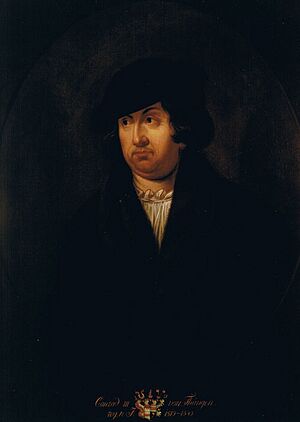Konrad von Thüngen facts for kids
Quick facts for kids Konrad von Thüngen |
|
|---|---|
| Prince-Bishop of Würzburg | |

Konrad von Thüngen
|
|
| See | Würzburg |
| Appointed | 13 April 1519 |
| Reign ended | 16 June 1540 |
| Predecessor | Lorenz von Bibra |
| Successor | Konrad von Bibra |
| Personal details | |
| Born | c. 1466 |
| Died | 16 June 1540 (aged 73–74) Fortress Marienberg, Würzburg |
| Denomination | Roman Catholic |
Konrad von Thüngen (born around 1466 – died June 16, 1540) was an important leader in Germany. He was the Prince-Bishop of Würzburg from 1519 until his death. A Prince-Bishop was a special kind of ruler. He was both a religious leader (a bishop) and the political leader of a territory (a prince).
Contents
Konrad von Thüngen's Life
Early Life and Role
Konrad was born around 1466 into a noble family from Franconia, a region in Germany. Being part of a noble family meant he had a high social standing.
He became the Prince-Bishop of Würzburg on February 15, 1519. His appointment was officially approved by Pope Leo X on April 13, 1519. This made him a very powerful person in his region.
The German Peasants' War (1525)
In 1525, a major event happened during Konrad's rule: the German Peasants' War. The Prince-Bishopric of Würzburg was a main area for this conflict.
What Caused the War?
Farmers, also known as peasants, were very unhappy. They had to pay high taxes and were forced to work for their landlords. They wanted more freedom and fairer treatment. So, they decided to rebel.
Würzburg Under Siege
During the war, the city of Würzburg was surrounded by the peasant armies. Konrad von Thüngen was forced to leave the city for his safety. The peasants found leaders like Götz von Berlichingen and Florian Geyer.
End of the Conflict
Eventually, the peasant armies were defeated. An army called the Swabian League pushed them back. Konrad von Thüngen was able to return to Würzburg. Those who had taken part in the rebellion faced serious consequences.
Later Years and Death
Konrad von Thüngen continued to rule as Prince-Bishop. He died on June 16, 1540, at Fortress Marienberg in Würzburg.

